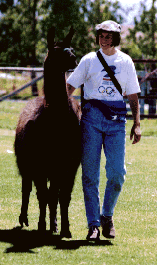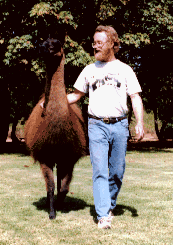Llama care, management and resources
- Llama FAQ
- Llama literature
- Basic care
- Castration
- Spaying
- About breeding llamas
- Handling young llamas
- Misdirected territorial aggression
- How old should llamas be for training and work?
Training
Fiber from llamas
Llamas
as guardians
Classic performance llamas
Communicating
Our llama family
Just for fun
Cria photos
Training consultation
Performance
llama analysis
Training
Just as humans must be educated in social and intellectual matters to function acceptably in society, llamas -- as domestic animals -- must also receive education about functioning with humans and in a largely human-created environment. "Training" is the word that is used to mean "teaching animals," and try as we might, we can't effectively dispense with the word and the attitudes that come with it -- it is simply too ingrained in our society. So, we simply say that we "train," while understanding, in our own minds, that we really mean "educate" and let others choose the meaning with which they are most comfortable.
That having been said, what most people expect in a "trained llama" is a "flawlessly programmed llama." They forget that animals continue to make choices throughout their lives, and one of those choices is whether or not a particular human deserves their trust and thus their compliance. An educated llama who doesn't trust his or her human will seem extremenly uneducated when in fact it is the human's problem!
Basics
Certain tasks are prerequisite for any of our llamas. Law requires that llamas not on our property be under physical control by means of halter and lead -- this implies that they allow themselves to be approached and haltered, and that they also respect and understand the concept of leading. Health needs dictate that llamas allow their coat to be groomed, their nails to be trimmed, and their bodies to be inspected. In turn, these tasks imply the knowledge and acceptance of standing while tied, lifting individual feet when asked, and standing still without restraint. Courtesy demands that while interacting with a human, llamas interact with other humans and other llamas in specific ways -- and refrain from certain other actions. All these constitute a portion of what is socially acceptable behavior for a domestic animal. Our manner of teaching plays an important role in not only how well these tasks are performed, but, just as important to us, how comfortably and willingly the llama acquieses. What is often overlooked is regarding the importance of mastering the basics before attempting to comprehend more advanced levels of schooling.
Elementary School
In order to fully enjoy a human-companion animal relationship, we've found that some additional education becomes pertinent. Walking on a loose lead, relying only on visual and verbal cues, is not only enjoyable for both llama and handler, but is one important litmus test of partnership between the two. Daily or periodic walks are enjoyable for both llamas and humans. In order to enjoy more variety and avoid trauma and trouble on these excursions, a llama must also understand a number of simple concepts: proper protocol for negotiating gates, to follow behind on a narrow trail, how to respond in traffic, crossing pedestrian and vehicle bridges, and how to negotiate shallow water, mud, close trees and brush, low barriers such as fallen logs, and man-made "obstacles" such as steps and ramps. Finally, a whole new world is opened up when a llama loads readily into vehicles, travels well, and has been taught s/he can anticipate taking advantage of periodic "rest stops" rather than being forced to soil his or her traveling accomodations against his or her own sanitation standards.
Occupational Studies
Performance llamas may earn their keep by packing, driving, or showing. We've defined our own expectations for each of these occupations on a combination of basic equine achievements and additional pertinent tasks that llamas are uniquely suited to perform. Although our llamas achieve these moderate standards and thus become very enjoyable and willing working partners, the majority of llamas currently are not even expected to willingly perform the basic tasks outlined above, and are only forced through the most essential occupation-specific tasks. These llamas are not enjoyable until they have been reeducated, and sometimes rehabbed -- a process that can take substantially more time than if they had received proper training in the first place. Until there are enough well-educated llamas visible to the public and thus creating more discerning buyers, the current embarrassing level of "performance" will unfortunately continue to be the norm.
- Packing
For packing, we require that a llama stands anywhere untied, tethers, stands for saddling, stands and kushes as directed for loading and unloading, manuevers loads between objects, crosses streams alone with verbal direction, and strings (lead, middle, caboose)
- Basic Driving
A pleasure driving llama uses distinct gaits on verbal command (walk, jog, run), ground drives (starts, turns, and stops without a "header"), stands untied for harnessing, accepts all types of llama-drawn vehicles, drives on roads and trails, maneuvers around basic obstacles, and backs into and out of narrow spaces.
- General Show Obstacles
An entry-level show llama can negotiate all obstacles defined by current show association regulations.
- Pet Therapy
Therapy llamas are very reliably "house-broken"; negotiate all types of structures and restrictions found in buildings such as rooms, hallways, floor surfaces, elevators, and long flights of stairs; kush and/or willingly bring head down for easier access; and are "spook-proof."
High School
Borrowing a term from the equine world and expanding its meaning to include several disicplines, "high school" training is pursuing further education for its own sake. If mastery of moderate occupational standards is uncommon, pursuit of high school work is very rare. Although the definition of driven dressage is drawn heavily from its equine counterpart, off-lead work is being defined and redefined as it is pursued by those who practice it, and the details of master-level obstacle competition are not even in the hands of the trainers, but of show management.
Neck leading -- an intermediate
off-lead technique


(photo by Carolyn Blalock) ........................................................
Return to Lost
Creek Llamas home page